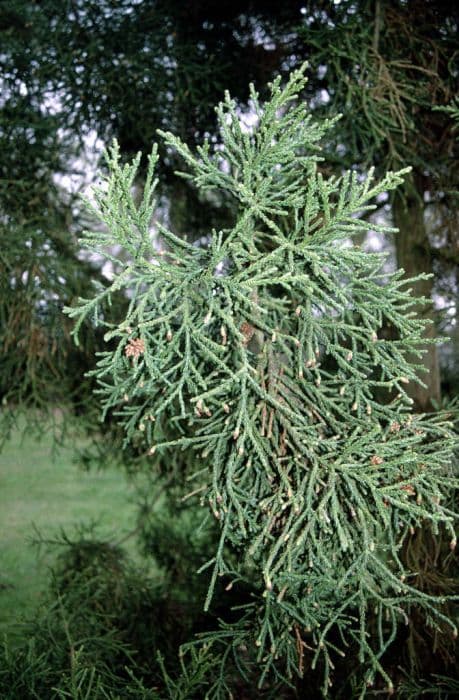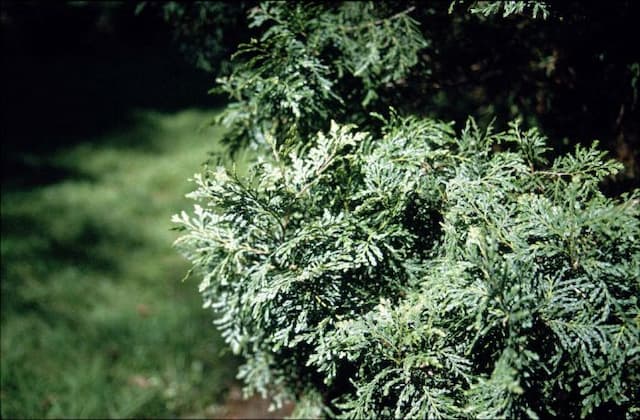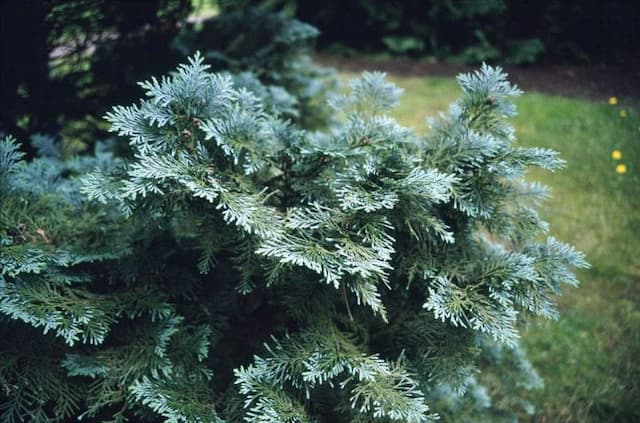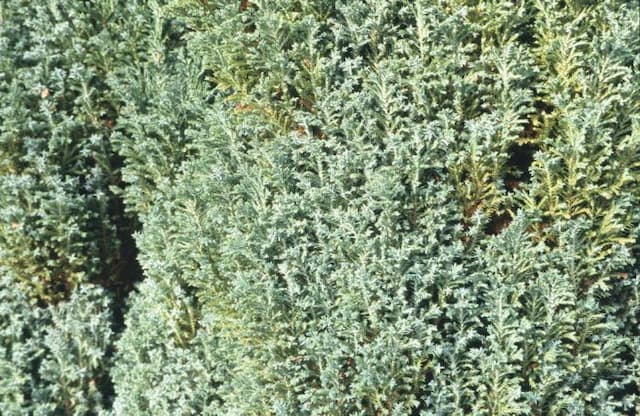Leyland Cypress × Cuprocyparis leylandii 'Silver Dust' (v)

ABOUT
The Leyland cypress 'Silver Dust' is a visually striking plant characterized by its evergreen foliage that exhibits a unique, eye-catching variegated pattern. The leaves of this plant are scale-like, arranged densely on its branches, giving it a textured appearance. Each leaf showcases a blend of soft green tones, mixed with spots and specks of creamy white, resembling a dusting of silver – hence the name 'Silver Dust'. This variegation adds a sparkling effect to the plant, especially under sunlight. This cultivar stands out with its conical shape, making it a popular choice for decorative hedges or as a standalone specimen in a garden setting. The branches grow in a somewhat horizontal pattern and have a tendency to create a lush, thick screen when planted in rows. The overall look of the Leyland cypress 'Silver Dust' is one of elegance and vibrancy, with the silver-tinged foliage providing a contrast that can complement a wide variety of landscapes.
About this plant
 Names
NamesFamily
Cupressaceae.
Synonyms
Leyland Cypress, Leylandii 'Silver Dust'.
Common names
Cupressocyparis leylandii 'Silver Dust', Cupressus × leylandii 'Silver Dust', Callitropsis × leylandii 'Silver Dust', Hesperotropsis leylandii 'Silver Dust', × Hesperocyparis leylandii 'Silver Dust'.
 Toxicity
ToxicityTo humans
Leyland Cypress is generally not considered to be toxic to humans. Ingestion of this plant is unlikely to cause serious harm, but as with many plants, individual allergic reactions or irritation may occur if plant material is ingested, and it's always prudent to exercise caution and keep plant parts away from children who might inadvertently ingest them.
To pets
Leyland Cypress is not known to be highly toxic to pets. However, ingestion can potentially cause mild gastrointestinal upset, such as vomiting or diarrhea, due to the plant material being irritating to the stomach or intestines. As with humans, it is always best to prevent pets from ingesting plants, as individual animals may have different sensitivities or reactions.
 Characteristics
CharacteristicsLife cycle
Perennials
Foliage type
Evergreen
Color of leaves
Green
Height
60 feet (18 meters)
Spread
15 feet (4.5 meters)
Plant type
Tree
Hardiness zones
6
Native area
Cultivar
Benefits
 General Benefits
General Benefits- Fast-growing: Leyland Cypress 'Silver Dust' grows quickly, providing a rapid solution for privacy screens or hedges.
- Visual Appeal: It has attractive silvery-green foliage that can enhance the aesthetic of gardens and landscapes.
- Drought Tolerance: Once established, it is relatively drought tolerant, requiring less frequent watering compared to many other plants.
- Low Maintenance: It requires minimal pruning and care once it has reached the desired size and shape.
- Sound Barrier: The dense foliage can help reduce noise pollution from roads or neighbors.
- Windbreak: It can act as a windbreak, protecting gardens and properties from strong winds.
- Privacy: Because of its dense growth, it is ideal for creating privacy screens and obscuring unsightly views.
- Wildlife Habitat: Provides shelter and habitat for various species of birds and insects.
- Versatility: Able to grow in a variety of soil types and conditions, making it a versatile choice for many landscapes.
- Adaptability: It is capable of adapting to a range of climates, enhancing its survivability in various regions.
 Medical Properties
Medical PropertiesThis plant is not used for medical purposes.
 Air-purifying Qualities
Air-purifying QualitiesThis plant is not specifically known for air purifying qualities.
 Other Uses
Other Uses- Acoustic Barrier: Leylandii 'Silver Dust' can be used to reduce noise pollution by planting a dense hedge along the edges of a property.
- Windbreak: These trees can act as a windbreak to protect more fragile plants and reduce soil erosion on the property.
- Privacy Screening: Due to its rapid growth and dense foliage, Leylandii 'Silver Dust' is ideal for creating privacy screens or living fences.
- Erosion Control: The extensive root system of Leylandii 'Silver Dust' can help stabilize slopes and prevent soil erosion.
- Topiary Art: Leylandii 'Silver Dust' can be trimmed and shaped into various topiary forms for decorative landscape design.
- Wildlife Shelter: These trees provide nesting sites and shelter for birds, enhancing biodiversity.
- Photography Backdrop: The silvery foliage of Leylandii 'Silver Dust' makes it a desirable background for outdoor photography.
- Outdoor Events: Tall and dense hedges of these trees can create intimate spaces for garden weddings or other outdoor events.
- Theme Gardens: Leylandii 'Silver Dust' can be used in theme gardens to emulate the landscapes of different regions or historical periods.
- Seasonal Decor: Branch clippings from Leylandii 'Silver Dust' can be used for holiday wreaths and festive decoration due to their unique foliage color.
Interesting Facts
 Feng Shui
Feng ShuiThe Leyland Cypress is not used in Feng Shui practice.
 Zodiac Sign Compitability
Zodiac Sign CompitabilityThe Leyland Cypress is not used in astrology practice.
 Plant Symbolism
Plant Symbolism- Strength and Endurance: Leyland Cypress 'Silver Dust' is a hybrid plant known for its vigorous growth and resilience, symbolizing the ability to thrive and endure through a variety of conditions.
- Privacy: Often used as a privacy hedge, the Leyland Cypress represents the need for personal space and boundaries in one's life.
- Evergreen Nature: As an evergreen plant, it symbolizes eternal life and steadfastness, reflecting qualities of constancy and faithfulness.
 Water
WaterLeyland Cypress 'Silver Dust' should be watered deeply and thoroughly, which typically involves applying enough water to soak the soil to a depth of around 8 to 12 inches. When the tree is young and establishing its root system, you should water it once or twice a week. As the plant matures, decrease the frequency to once every 2 to 3 weeks, depending on weather conditions. In terms of the amount, this equals roughly 15 to 20 gallons of water every 2 to 3 weeks during the growing season, but the exact amount can vary based on soil type and climate.
 Light
LightLeyland Cypress 'Silver Dust' thrives best in full sun to partial shade. The ideal location would provide at least 6 hours of direct sunlight per day. It's important to ensure the plant is not shaded by buildings or other plants during the majority of the day, as insufficient light could impact its growth and health.
 Temperature
TemperatureLeyland Cypress 'Silver Dust' is able to withstand a range of temperatures from approximately 0°F to over 100°F. However, the ideal temperature for optimal growth lies between 40°F and 80°F. Extreme temperatures at the lower or upper ends should be avoided to maintain the health of the tree.
 Pruning
PruningLeyland Cypress 'Silver Dust' should be pruned to maintain its shape and density and to remove any dead or diseased branches. It is best pruned in the late winter or early spring before new growth begins. Generally, pruning once a year is sufficient, but if you are using the tree for hedging, it may need shaping 2 to 3 times during the growing season. Always use clean, sharp tools to make precise cuts.
 Cleaning
CleaningNot needed
 Soil
SoilLeyland Cypress 'Silver Dust' thrives in well-draining, loamy soil that is slightly acidic to neutral in pH, ideally ranging from 6.0 to 8.0. The best soil mix can be made by blending garden soil with compost and a small amount of sand or perlite to ensure good drainage.
 Repotting
RepottingLeyland Cypress 'Silver Dust' being a fast-growing tree does not typically need regular repotting. It's usually planted directly in the ground where it can grow without the constraints of a pot. If grown in containers, repotting might be required every 2 to 3 years to accommodate its rapid growth.
 Humidity & Misting
Humidity & MistingLeyland Cypress 'Silver Dust' is tolerant of a wide range of humidity levels and can do well in the typical outdoor humidity conditions. It does not have specific humidity requirements, making it quite adaptable to various outdoor environments.
 Suitable locations
Suitable locationsIndoor
Not ideal for indoor growth due to size.
Outdoor
Plant in full sun, well-draining soil, and space adequately.
Hardiness zone
6-10 USDA
 Life cycle
Life cycleLeyland Cypress 'Silver Dust' begins its lifecycle with seed germination, often facilitated by a pre-treatment to break dormancy such as stratification. The seedlings then establish themselves, developing roots and foliage as they enter the juvenile growth stage, rapidly growing in both height and girth. During the maturation phase, the tree expands its canopy and continues to gain height, eventually reaching its full size which can be substantial given its hybrid vigor. Reproductive maturity is reached and the tree begins to produce cones containing seeds, although propagation is often achieved through cuttings for this cultivar. Over the years, the Leyland Cypress 'Silver Dust' may undergo seasonal cycles of growth and dormancy, particularly in temperate climates. As the tree ages, it enters a senescence phase where growth slows and it may become more susceptible to disease or environmental stresses before eventually dying.
 Propogation
PropogationPropogation time
Spring to early summer
Propogation: Leyland Cypress 'Silver Dust', a popular ornamental hybrid conifer, is typically propagated through semi-hardwood cuttings. The optimal time to take cuttings for propagation is during the late summer to early fall, when new growth has matured enough but hasn't fully hardened. A successful approach involves selecting healthy, disease-free shoots and cutting sections between 6 to 8 inches long (about 15 to 20 centimeters) with a sharp, sterilized tool. These cuttings should then have the lower needles removed, leaving a few at the top for photosynthesis, and the cut end dipped in rooting hormone to encourage root development. The prepared cuttings are then inserted into a well-draining potting mix, ensuring that the mix stays moist but not waterlogged, and placed in a sheltered environment with indirect light. A propagation environment with consistent humidity can be maintained by covering the cuttings with a plastic bag or propagator lid until roots have formed, which can typically take several weeks to a few months. It's important to keep the cuttings at a stable temperature, preferably around 65 to 75 degrees Fahrenheit (about 18 to 24 degrees Celsius), to promote rooting.









